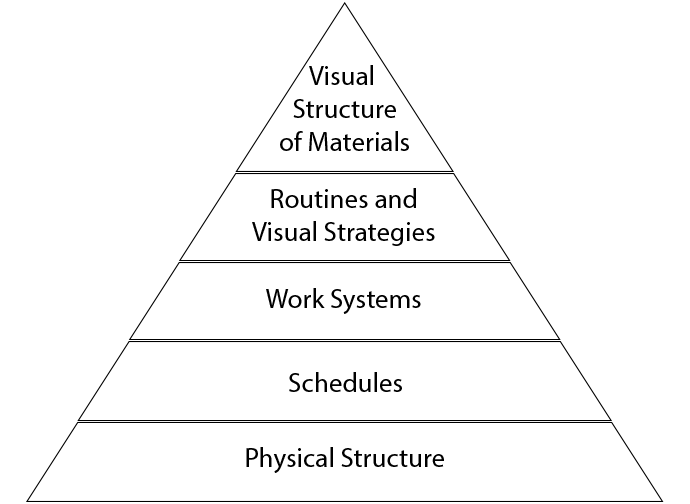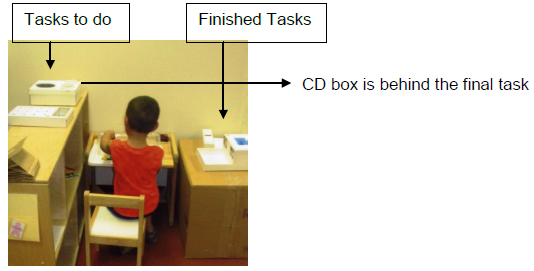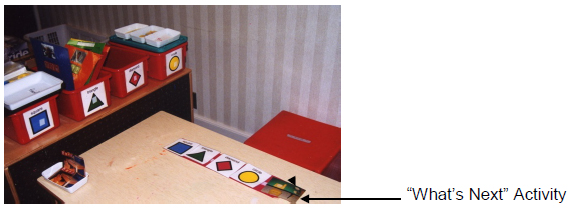Structured Teaching: an overview
Structured Teaching is a set of teaching techniques developed by Division TEACCH (Training and Education of Autistic and related Communication-handicapped Children), a state-wide program serving individuals with autism spectrum disorders (ASD) in North Carolina.
These teaching strategies are based on an understanding of how autism impacts the thinking, learning, and behavior of an individual with ASD. Differences in auditory processing, imitation, motivation, and organization can hinder the educational success of students with ASD, as most traditional teaching strategies rely heavily on verbal instructions, demonstration, social reinforcement, and sequencing chunks of information or directives.
Structured Teaching strategies, however, capitalize on the strengths of students with ASD. These include providing predictable and meaningful routines through the use of structure, adding visual/structural supports to classroom instruction and activities to increase engagement and independence, and clearly organizing classroom spaces and teaching materials to reduce anxiety and increase appropriate behavior.
There are five elements of Structured Teaching that build on one another, and all emphasize the importance of predictability and flexible routines in the classroom setting. Division TEACCH developed a visual to illustrate the Structured Teaching components — the Structured Teaching pyramid:

This article focuses on work systems in the school setting.
What is a work system?
A work system is an organizational system that gives a student with ASD information about what is expected when he/she arrives at a classroom location. A work system is defined by Division TEACCH as a systematic and organized presentation of tasks and materials that visually communicates at least four pieces of information to the student (Schopler, Mesibov, & Hearsey, 1995):
- The tasks/steps the student is supposed to do. What is the nature of the task? Does it involve sorting by shape, writing an address, making popcorn, or recycling cans?
- How many tasks/steps there are to be completed. Visually represent how much work is to be done. If a student is to cut 10 coupons, give only 10 coupons so he/she can visualize completion. Steps may be represented by more abstract cues such as numbers, shapes, poker chips, or pictures of high interest items, such as Thomas the Train cars.
- How the student knows he/she is finished. The student should independently recognize the end of the activity through structure within the task, use of a finished box, timer, or other visual cue such as a stop sign.
- What to do when he/she is finished. Indicate next scheduled activity. May need to use a highly desired item/activity to increase motivation, though often being “finished” is motivating enough.
While a picture schedule directs a student WHERE to go, a work system instructs a student on WHAT TO DO once they arrive in the scheduled area. Work systems are also often referred to as mini-schedules, a schedule within a schedule, to-do-lists, or activity schedules.
Why do I use a work system with students with ASD?
The goal of independence is a priority for all children, yet when working with children with ASD, independence is the key to successful community inclusion and future employment. Establishing independence as a curricular goal is vital, as is gaining an understanding of the possible barriers to independence that students with ASD face. Gary Mesibov, Director of Division TEACCH, explains that students with autism may face several unique challenges when learning. The following difficulties may be an obstacle to the development of independent skills:
- Organization is often difficult for students, and the challenge of understanding demands and developing a plan of action may overwhelm or immobilize a student with ASD. Collecting all of the needed materials to complete an assignment may be a complicated organizational demand for a student with ASD.
- Distractibility caused by internal or external factors may also hamper a student’s ability to complete work on his/her own. Students with ASD may have difficulty prioritizing the visual and auditory information in their environment, which may interfere with their independence.
- Sequencing can hinder a student’s ability to become independent, as the relationships between tasks or steps may not be meaningful and may be disregarded by a student with autism. Remembering the exact order of tasks, or steps within a task, may be challenging for students.
- Generalization difficulties are also discussed by Mesibov as a potential impediment to independence. Students with ASD may perform a task independently in one situation or setting, yet may not apply what they have learned in a novel situation. Students may miss the central principles of an activity, instead focusing on the specific details.
- Independent initiation is also difficult for students with ASD, especially during lengthy sequences of activities. A student may have learned to complete the routine in the cafeteria, yet still require prompts to initiate each part of the routine (i.e. get the tray, select the drink, pick up utensils). Individuals with ASD often learn to wait for others to prompt their every move, which results in a lack of independence.
Monitoring the balance between 1:1 instruction and assistance with the awareness that the development of over-reliance may occur is essential when instructing students with ASD. Several studies have shown that students with ASD are not able to continue productive and appropriate responding with the removal of close adult supervision (Dunlap & Johnson, 1985; Dunlap, Koegel, & Johnson, 1987; Stahmer & Shreibman, 1992). Further research indicates that without the reinforcers or contingencies provided by adults, students with ASD have difficulty maintaining independent on-task behavior (Dunlap & Johnson, 1985; Dunlap, Koegel, & Johnson, 1987).
How do I implement a work system?
A work system provides all of the required information without adult prompting and teaches the student to attend to visual cues (rather than verbal directives) when completing a task. A work system assists in organizing a student with ASD by providing a systematic work routine—working from left-to-right or top-to-bottom. Students do not have to plan where to begin or how to proceed. Work systems can be used with any type of task or activity (e.g., academic, self-help, leisure), across settings (e.g., independent work area, cafeteria, place of employment), and for individuals at all functioning levels (e.g., systems can range from concrete to abstract).
Left to Right Work System
For a concrete leaner (a students who may not respond to language), a left-to-right work system may be the most appropriate way to present work materials. When the student arrives at the work location (i.e. 1:1 work area with an adult, small group work area, or an independent work area), all of the materials to be completed will be placed to the left of the student on a shelf or table. To the student’s right will be a “finished” location (i.e. a box, basket, or shelf). The student is instructed to complete the activities on his/her left (with your guidance and assistance if materials are just being introduced), and place them in the “finished” location upon completion. The student is able to see how much work and what work is required, and the concept of finished is visible through the transfer of materials to the “finished” location. The students is also able to see what activity will be happening next, as an object, photo, or icon from his/her schedule is placed at the end of the task sequence to direct the student to the next activity. Once a student has learned how to use the work system independently, and has mastered a number of skills or tasks, the student should regularly practice activities with a work system independently.
For example:
- Activity: Practice mastered academic tasks (e.g., filing by letter, sorting by color, answering math problems)
- Setting: Independent Work Area
- Functioning Level: Concrete (using left-to-right work system and objects to transition from one activity to the next)
For a student that has several academic activities to practice independently, the teacher will arrange them in baskets/folders on a shelf to the student’s left. At the end of the row of baskets is a computer CD box, indicating that the computer is the next scheduled activity. The student will complete the first activity and put it in a box/shelf for finished work on the right, then move to the second activity. When all that is left on the shelf is the CD box, the student will transition with the CD box to the computer.

Matching Picture Work System
Work systems may be adapted for a student with higher level work skills by indicating that the work tasks should be completed in a sequential order. This is called a matching work system. When the student arrives at the work location, a strip of visual information will answer the work system questions for him/her. On this strip will be pictures, icons, or words, and to the student’s left with be work tasks on shelf or in containers that are labeled with an identical photo, icon, or word. The student will take off the first symbol, match it to the corresponding activity, complete the activity, and place it in the “finished” location. The work continues until all symbols are matched to the corresponding tasks, and the completed activities are placed in the finished basket. The student is able to see what is happening next as an object, photo, or icon from his/her schedule is placed at the end of the task sequence to direct the student to the next activity.
For example:
- Activity: Practice mastered academic tasks (e.g., filing by letter, sorting by color, answering math problems)
- Setting: Independent Work Area
- Functioning Level: More abstract (using matching work system and photos to transition from one activity to the next)
The student has a strip of shapes velcroed to her work space. She has multiple work tasks located on a shelf to her left. To complete tasks in her matching work system, she takes off the square and matches it to the square located on one of the work jobs. This is the task she must complete first. She continues matching shapes to tasks in order to complete the activities in a specified sequential order. When the shapes are matched and the tasks are completed and placed in the finished basket, she takes the photo cue directing her to the next activity (snack).

Icon Work System
Information in a work system can be presented with icons or written language as well. The concept of finished may also be adapted for students who do not need a separate or designated location to place completed tasks. Work system information can be placed in a “finished” envelope or pocket, or it can be crossed off when it is completed. Work systems can be located across setting, and are helpful in locations such as the bathroom, cafeteria, general education setting, music classroom, job setting, and/or playground if needed. Students can be taught to look for the work system upon arrival in any location so he/she can understand what is expected and what activity will occur next.
For example:
- Activity: Hand washing
- Setting: Bathroom
- Functioning Level: More abstract (using icons)
For a student that requires prompting and assistance with the hand washing sequence, a work system can be created for use in the bathroom. Each step of the routine is indicated visually, and as the student completes each step, the icon is placed in the “Finished Pocket”. When the steps are completed and all of the icons are in the pocket, the student knows that hand washing is finished, and is directed to the next activity (e.g., go to the table).

Written Work System
For example:
- Activity: Art
- Setting: Group Area
- Functioning Level: Abstract (following written directions)
For a student that has difficulty following group directions, and sequencing steps to a complex project, a written work system can be used. A written list of the steps required in sequential order, as well as an explicit notion of finished and the next activity, increases independence and task completion.

Experience with the use of work systems has shown that a student’s overall productivity increases when he/she understands how much work there is to do, as well as when it is finished, and what activity is upcoming. Use of work systems help students with ASD become more organized, more attentive, and more capable in carrying their skills across settings independently. Work systems reduce the number of adult prompts and the use of contingencies and reinforcers, as the structure of the system provides motivation and meaning to the students.
Tips for implementing work systems
- Provide only the materials the student will need for the specific task/activity to decrease confusion.
- Use work systems in a variety of settings (e.g., circle time, social groups, playground, home, doctor visits) to increase generalization across locations and adults.
- Teach the work system with minimally invasive prompts so the adult/prompts do not become part of the work routine (e.g., prompt nonverbally, direct students to visual cues, prompt from behind so adult is not part of the student’s visual field, fade prompts as quickly as possible to maximize independence).
- Create smaller, more portable work systems (e.g. in a notebook, file box) for students who travel to different settings throughout the school day.
- Incorporate student’s interests in the visual cues used in the works system (e.g. students can match pictures of SpongeBob on their work system).
